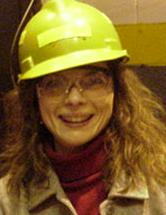Safety

... and the risks in maintenance.
To improvise is the origin of various risks.
Human failures

Human failures and their roots (SwissRe)
Planning and instructions
For safe and efficient working, all procedures must be planned in detail. Special risks have to be
eliminated. Instruction about safety is necessary before every repair work.
Breaks are important for recovering and relaxing.
(SUVAPRO: Ergonomie, Erfolgsfaktor für jedes Unternehmen)
Arc welding
Personal protection
Use suitable protective clothing and approved helmet / glasses
Use a supply of fresh air to dilute ambient atmosphere
Isolate the hot workpiece to prevent inadvertent contact (warning signs)
Removal of contamination and protective coatings before welding
Use a fume extractor or suitable ventilator to remove fumes from atmosphere
Work in suitable welding position to minimise risk of inhaling fumes - working
back-to-wind when outside
Risks of electrocution
The following are examples of situations involving increased risk of
electrocution:
Workplaces where there is limited freedom of movement, requiring the welder to
kneel, squat or lie and exposing parts of the body to contact with electrically
conductive materials
Workplaces which are either wholly or in part circumscribed by materials which
are electrically conductive and with which the welder will inevitably come in
contact, perhaps accidentally
Wet, damp or hot conditions which might diminish natural body resistance and
render inoperative any insulating properties of the work materials.
Legislation differs in each country.
Noxious gases
Ozone (O3)
Intense ultraviolet radiation from the arc can transform ordinary air oxygen
into ozone which, if inhaled causes irritation of the mucous membrane and
respiratory passage.
Symptoms: eye irritation, dry throat, coughing.
Phosgene (COCl2)
Chlorinated hydrocarbon vapours (e.g. trichloroethylene) are transformed by
intense radiation into phosgene, an extremely poisonous gas. It stimulates the
sweet taste buds, being noticeable even in small concentration.
Safety precautions:
- Use of fume extractor
- Systematic ventilation of the workplace
- Avoid welding in proximity of chlorinated hydrocarbons.
Fire protection
Do not weld in areas with explosion risks
Protect joints and gaps to avoid accidental drops of molten metal
Use fire-protective screens
Remove anything inflammable, dampen any endangered materials
Cooling by water of areas adjacent to the welding zone
Collect molten drops in water or wet sand, etc.
Electrical equipment and machines can if laid on the top of the workpiece cause
short circuit in the earthing.
Gas cylinders
- Make sure the cylinders cannot fall over
- Keep the cylinders away from any source of heat
- Never use oil and grease on the valves or pressure regulators
- When the job is finished, close the valves and pressure regulators
- In the event of gas leak, or a fire, shut the cylinder valves immediately - cool any cylinders extensively with water.
Powder flame spraying, arc spraying, HVOF and plasma spraying
Workshop and work station: to consider
Supply of fresh air and local extraction of gases, vapours, fumes, overspray,
etc.
External influences / Protection of surroundings
Observe safety rules on
Gas cylinders, pressure regulators
Gas pipes / Flexible hoses
Safety devices
Spray guns (or torches)
Manipulators and mechanical positioning devices
Protection devices
Personnel protection measures against
Visible and invisible rays and the flame
Noise (up to 130 dB)
Danger of falling objects (production areas, on site, etc.)
Gases, vapours, fumes and overspray
Fire prevention includes
Authorisation to do the work
All combustible objects are removed from the place of work
Arrangement of gas cylinders, tightness of connections and hoses
Emergency exits remain always free
Having ready appropriate fire-fighting materials
Working in closed spaces - heightened danger
Contamination of the air in the space with gas, vapours, fumes or overspray which are
noxious or inflammable
Oxygen starvation of the air = danger of life !!
Artificial aeration with oxygen = danger of life !!
Heightened electrical danger
Inappropriate supervision
Difficult emergency exits
Heightened electrical danger
Workplaces where there is limited freedom of movement, requiring the welder to
kneel, squat or lie and exposing parts of the body to contact with electrically
conductive materials
Workplaces which are either wholly or in part circumscribed by materials which
are electrically conductive and with which the personnel will inevitably come
in contact, perhaps accidentally
Wet, damp or hot conditions which might diminish natural body resistance and
render inoperative any insulating properties of the work materials.
Legislation differs in each country.
Brazing
Personal protection
- Use suitable protective clothing and approved glasses/ infrared and visible
- Use a supply of fresh air to dilute ambient gases
- Use a fume extractor or suitable ventilator to remove fumes from atmosphere
- Work in suitable position to minimise risk of fume by inhalation - working
back-to-wind when outside
- Remove all contamination or protective coatings
- Isolate the hot workpiece to prevent inadvertent contact (warning signs)
If filler metals with Cadmium are overheated, cadmium fumes can be generated.
Fluxes
- Protect the eyes
- Avoid hand / skin contact
- Ensure proper ventilation
- Wash carefully after accidental skin contact
- Retain fluxes in original sealed containers after use - store in accordance with recommendations
Fire protection / Explosion protection
- Keep a safe distance, use fireproofed protective screens
- Remove anything inflammable, dampen any endangered materials
- Dont work in zones where there is any danger of an explosion
- Cooling by water of areas adjacent to the brazing zone
- Avoid unburned gases are trapped in cavities or reaching other sites
Gas cylinders
- Make sure the cylinders cannot fall over
- Keep the cylinders away from any source of heat
- Never use oil and grease on the valves or pressure regulators
- When the job is finished, close the valves and pressure regulators
- In the event of gas leak, or a fire, shut the cylinder valves immediately - cool any cylinders extensively with water.
For further information, on-site training, technical advise or project management, please do not hesitate to
contact us.
|
